英语广告语言的特征分析(英文)
- 格式:doc
- 大小:146.00 KB
- 文档页数:31
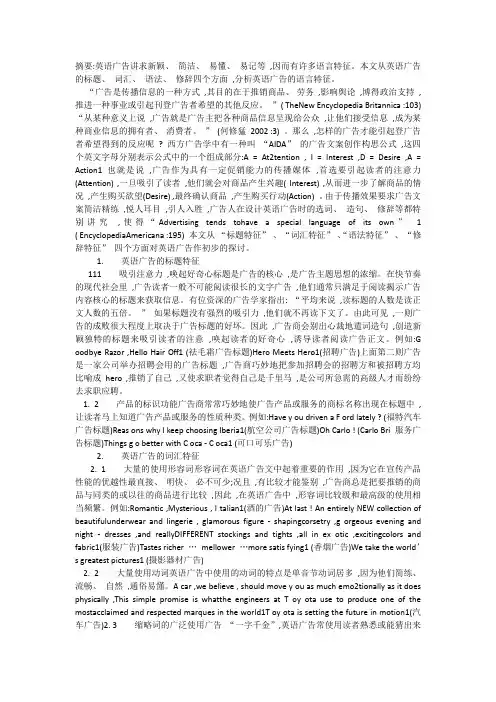
摘要:英语广告讲求新颖、简洁、易懂、易记等,因而有许多语言特征。
本文从英语广告的标题、词汇、语法、修辞四个方面,分析英语广告的语言特征。
“广告是传播信息的一种方式,其目的在于推销商品、劳务,影响舆论,博得政治支持,推进一种事业或引起刊登广告者希望的其他反应。
”( TheNew Encyclopedia Britannica :103)“从某种意义上说,广告就是广告主把各种商品信息呈现给公众,让他们接受信息,成为某种商业信息的拥有者、消费者。
”(何修猛2002 :3) 。
那么,怎样的广告才能引起登广告者希望得到的反应呢? 西方广告学中有一种叫“AIDA”的广告文案创作构思公式,这四个英文字母分别表示公式中的一个组成部分:A = At2tention , I = Interest ,D = Desire ,A = Action1也就是说,广告作为具有一定促销能力的传播媒体,首选要引起读者的注意力(Attention) ,一旦吸引了读者,他们就会对商品产生兴趣( Interest) ,从而进一步了解商品的情况,产生购买欲望(Desire) ,最终确认商品,产生购买行动(Action) 。
由于传播效果要求广告文案简洁精练,悦人耳目,引人入胜,广告人在设计英语广告时的选词、造句、修辞等都特别讲究,使得“Advertising tends tohave a special language of its own” 1 ( EncyclopediaAmericana :195) 本文从“标题特征”、“词汇特征”、“语法特征”、“修辞特征”四个方面对英语广告作初步的探讨。
1. 英语广告的标题特征111 吸引注意力,唤起好奇心标题是广告的核心,是广告主题思想的浓缩。
在快节奏的现代社会里,广告读者一般不可能阅读很长的文字广告,他们通常只满足于阅读揭示广告内容核心的标题来获取信息。
有位资深的广告学家指出: “平均来说,读标题的人数是读正文人数的五倍。

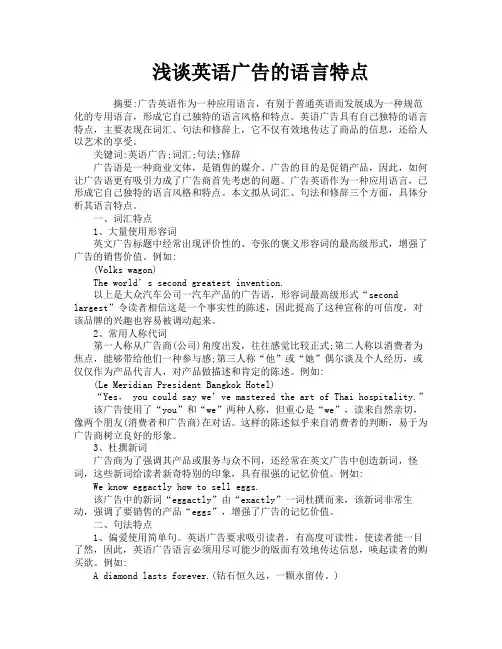
浅谈英语广告的语言特点摘要:广告英语作为一种应用语言,有别于普通英语而发展成为一种规范化的专用语言,形成它自己独特的语言风格和特点。
英语广告具有自己独特的语言特点,主要表现在词汇、句法和修辞上,它不仅有效地传达了商品的信息,还给人以艺术的享受。
关键词:英语广告;词汇;句法;修辞广告语是一种商业文体,是销售的媒介。
广告的目的是促销产品,因此,如何让广告语更有吸引力成了广告商首先考虑的问题。
广告英语作为一种应用语言,已形成它自己独特的语言风格和特点。
本文拟从词汇、句法和修辞三个方面,具体分析其语言特点。
一、词汇特点1、大量使用形容词英文广告标题中经常出现评价性的、夸张的褒义形容词的最高级形式,增强了广告的销售价值。
例如:(Volks wagon)The world’s second greatest invention.以上是大众汽车公司一汽车产品的广告语,形容词最高级形式“second largest”令读者相信这是一个事实性的陈述,因此提高了这种宣称的可信度,对该品牌的兴趣也容易被调动起来。
2、常用人称代词第一人称从广告商(公司)角度出发,往往感觉比较正式;第二人称以消费者为焦点,能够带给他们一种参与感;第三人称“他”或“她”偶尔谈及个人经历,或仅仅作为产品代言人,对产品做描述和肯定的陈述。
例如:(Le Meridian President Bangkok Hotel)“Yes,you could say we’ve mastered the art of Thai hospitality.”该广告使用了“you”和“we”两种人称,但重心是“we”,读来自然亲切,像两个朋友(消费者和广告商)在对话。
这样的陈述似乎来自消费者的判断,易于为广告商树立良好的形象。
3、杜撰新词广告商为了强调其产品或服务与众不同,还经常在英文广告中创造新词,怪词,这些新词给读者新奇特别的印象,具有很强的记忆价值。
例如: We know eggactly how to sell eggs.该广告中的新词“eggactly”由“exactly”一词杜撰而来,该新词非常生动,强调了要销售的产品“eggs”,增强了广告的记忆价值。
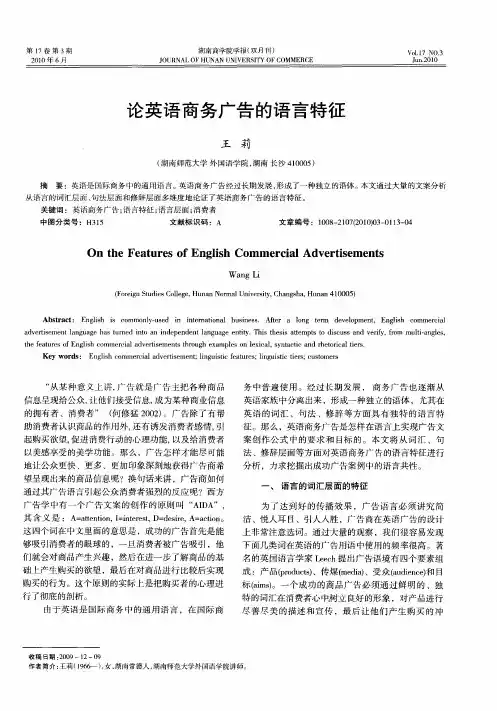
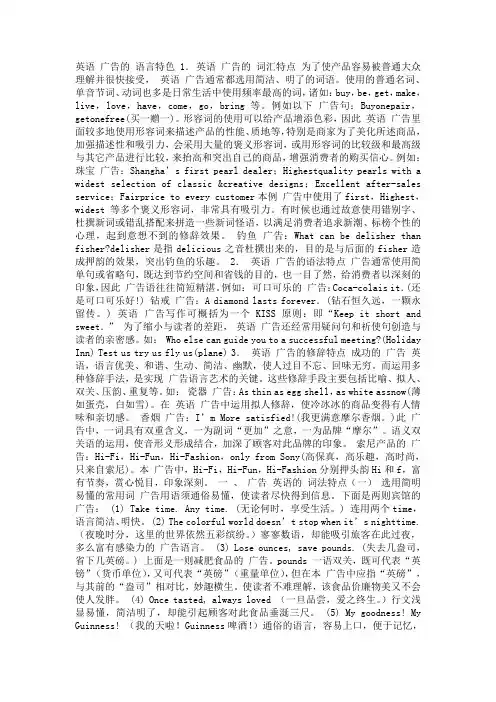
英语广告的语言特色 1.英语广告的词汇特点为了使产品容易被普通大众理解并很快接受,英语广告通常都选用简洁、明了的词语。
使用的普通名词、单音节词、动词也多是日常生活中使用频率最高的词,诸如:buy,be,get,make,live,love,have,come,go,bring等。
例如以下广告句:Buyonepair,getonefree(买一赠一)。
形容词的使用可以给产品增添色彩,因此英语广告里面较多地使用形容词来描述产品的性能、质地等,特别是商家为了美化所述商品,加强描述性和吸引力,会采用大量的褒义形容词,或用形容词的比较级和最高级与其它产品进行比较,来抬高和突出自己的商品,增强消费者的购买信心。
例如:珠宝广告:Shangha’s first pearl dealer;Highestquality pearls with a widest selection of classic &creative designs;Excellent after-sales service;Fairprice to every customer本例广告中使用了first,Highest,widest等多个褒义形容词,非常具有吸引力。
有时候也通过故意使用错别字、杜撰新词或错乱搭配来拼造一些新词怪语,以满足消费者追求新潮、标榜个性的心理,起到意想不到的修辞效果。
钓鱼广告:What can be delisher than fisher?delisher是指delicious之音杜撰出来的,目的是与后面的fisher造成押韵的效果,突出钓鱼的乐趣。
2.英语广告的语法特点广告通常使用简单句或省略句,既达到节约空间和省钱的目的,也一目了然,给消费者以深刻的印象,因此广告语往往简短精湛。
例如:可口可乐的广告:Coca-colais it.(还是可口可乐好!) 钻戒广告:A diamond lasts forever.(钻石恒久远,一颗永留传。
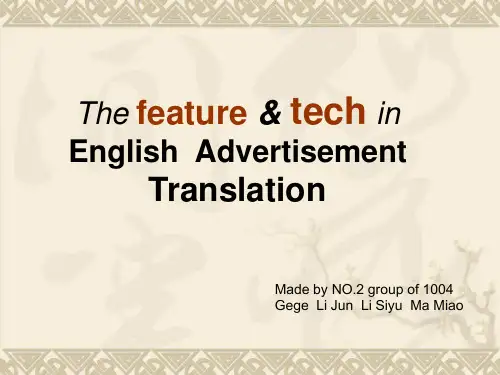
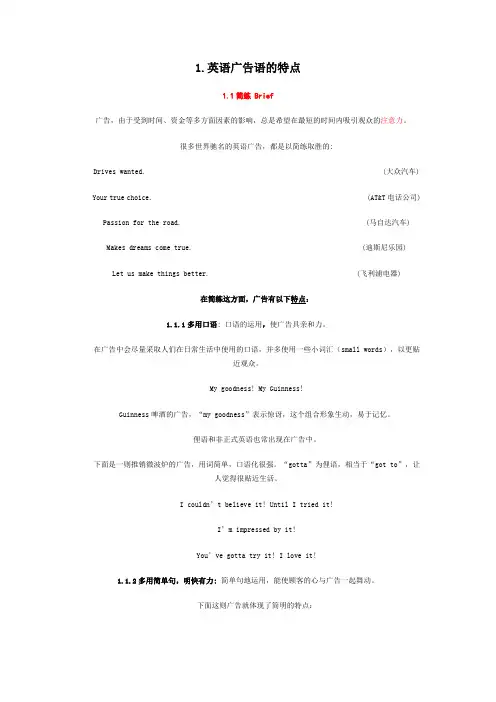
1.英语广告语的特点1.1简练 Brief广告,由于受到时间、资金等多方面因素的影响,总是希望在最短的时间内吸引观众的注意力。
很多世界驰名的英语广告,都是以简练取胜的:Drives wanted. (大众汽车) Your true choice. (AT&T电话公司) Passion for the road. (马自达汽车) Makes dreams come true. (迪斯尼乐园)Let us make things better. (飞利浦电器)在简练这方面,广告有以下特点:1.1.1多用口语: 口语的运用,使广告具亲和力。
在广告中会尽量采取人们在日常生活中使用的口语,并多使用一些小词汇(small words),以更贴近观众。
My goodness! My Guinness!Guinness啤酒的广告,“my goodness”表示惊讶,这个组合形象生动,易于记忆。
俚语和非正式英语也常出现在广告中。
下面是一则推销微波炉的广告,用词简单,口语化很强。
“gotta”为俚语,相当于“got to”,让人觉得很贴近生活。
I couldn’t believe it! Until I tried it!I’m impressed by it!You’ve gotta try it! I love it!1.1.2多用简单句,明快有力: 简单句地运用,能使顾客的心与广告一起舞动。
下面这则广告就体现了简明的特点:The Armco vacuum learner cleans rugs and drapes. It cleans hard surfaces like woods and vinyl floors. Even cement. The Armco vacuum cleaner is smooth and quiet. Try it! Make your floorssparkle with new cleanliness.1.1.3多用省略句,突出关键词。
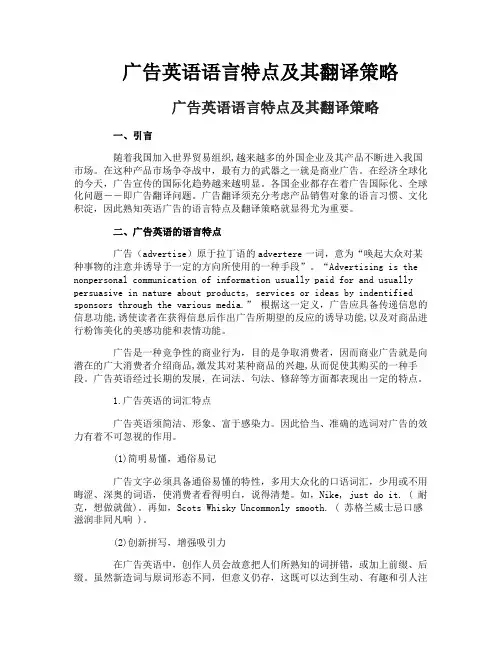
广告英语语言特点及其翻译策略广告英语语言特点及其翻译策略一、引言随着我国加入世界贸易组织,越来越多的外国企业及其产品不断进入我国市场。
在这种产品市场争夺战中,最有力的武器之一就是商业广告。
在经济全球化的今天,广告宣传的国际化趋势越来越明显。
各国企业都存在着广告国际化、全球化问题――即广告翻译问题。
广告翻译须充分考虑产品销售对象的语言习惯、文化积淀,因此熟知英语广告的语言特点及翻译策略就显得尤为重要。
二、广告英语的语言特点广告(advertise)原于拉丁语的advertere一词,意为“唤起大众对某种事物的注意并诱导于一定的方向所使用的一种手段”。
“Advertising is the nonpersonal communication of information usually paid for and usually persuasive in nature about products, services or ideas by indentified sponsors through the various media.” 根据这一定义,广告应具备传递信息的信息功能,诱使读者在获得信息后作出广告所期望的反应的诱导功能,以及对商品进行粉饰美化的美感功能和表情功能。
广告是一种竞争性的商业行为,目的是争取消费者,因而商业广告就是向潜在的广大消费者介绍商品,激发其对某种商品的兴趣,从而促使其购买的一种手段。
广告英语经过长期的发展,在词法、句法、修辞等方面都表现出一定的特点。
1.广告英语的词汇特点广告英语须简洁、形象、富于感染力。
因此恰当、准确的选词对广告的效力有着不可忽视的作用。
(1)简明易懂,通俗易记广告文字必须具备通俗易懂的特性,多用大众化的口语词汇,少用或不用晦涩、深奥的词语,使消费者看得明白,说得清楚。
如,Nike, just do it. ( 耐克,想做就做)。
再如,Scots Whisky Uncommonly smooth. ( 苏格兰威士忌口感滋润非同凡响 )。
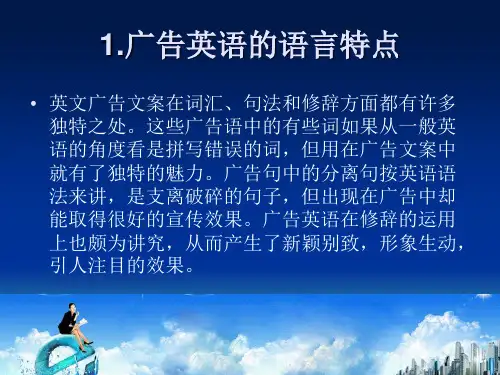
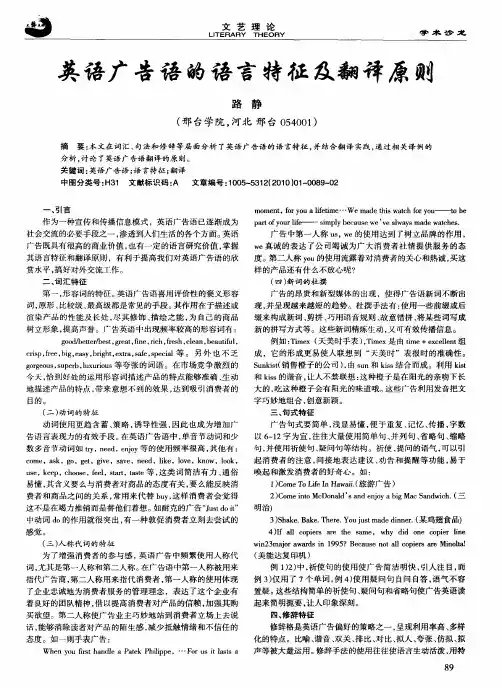
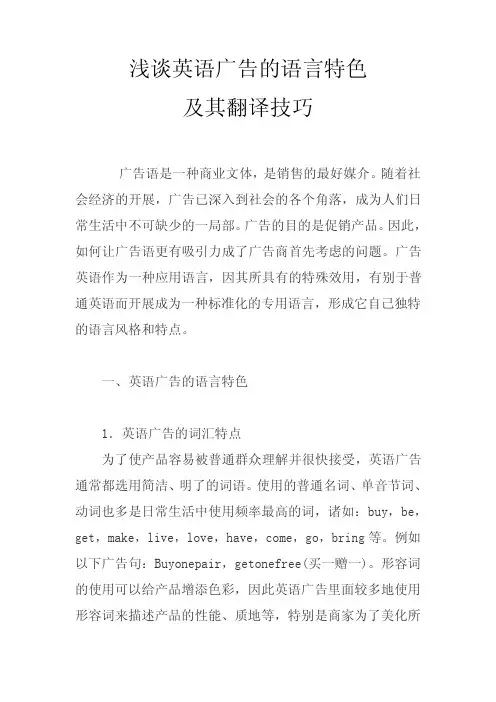
浅谈英语广告的语言特色及其翻译技巧广告语是一种商业文体,是销售的最好媒介。
随着社会经济的开展,广告已深入到社会的各个角落,成为人们日常生活中不可缺少的一局部。
广告的目的是促销产品。
因此,如何让广告语更有吸引力成了广告商首先考虑的问题。
广告英语作为一种应用语言,因其所具有的特殊效用,有别于普通英语而开展成为一种标准化的专用语言,形成它自己独特的语言风格和特点。
一、英语广告的语言特色1.英语广告的词汇特点为了使产品容易被普通群众理解并很快接受,英语广告通常都选用简洁、明了的词语。
使用的普通名词、单音节词、动词也多是日常生活中使用频率最高的词,诸如:buy,be,get,make,live,love,have,come,go,bring等。
例如以下广告句:Buyonepair,getonefree(买一赠一)。
形容词的使用可以给产品增添色彩,因此英语广告里面较多地使用形容词来描述产品的性能、质地等,特别是商家为了美化所述商品,加强描述性和吸引力,会采用大量的褒义形容词,或用形容词的比拟级和最高级与其它产品进行比拟,来抬高和突出自己的商品,增强消费者的购置信心。
例如: 珠宝广告:Shangha's first pearl dealer;Highestquality pearls with a widest selection of classic &creative designs;Excellent after-sales service;Fairprice to every customer本例广告中使用了first,Highest,widest等多个褒义形容词,非常具有吸引力。
有时候也通过成心使用错别字、杜撰新词或错乱搭配来拼造一些新词怪语,以满足消费者追求新潮、标榜个性的心理,起到意想不到的修辞效果。
钓鱼广告:What can be delisher than fisher?delisher 是指delicious之音杜撰出来的,目的是与后面的fisher造成押韵的效果,突出钓鱼的乐趣。
广告英语的语言特点英语广告翻译特点在现代社会中,广告已渗透到了人们生活的各个方面,成为社会生活的一个重要组成部分。
广告的语言也渐渐形成了独特的风格。
假如说文学作品,尤其是文学性最强的诗歌体裁作品,是语言的表意功能的体现,那么广告语言便是语言劝告功能的一种运用形式,它的最直接的目的是引起读者对某种商品的留意和爱好,使这种商品深深地印入读者观众的记忆中,并且因此而实行行动――购买这种商品。
英语广告文体的语言属于“鼓动性的语言”,有着剧烈的“劝说力”。
它能影响人们的价值观念,左右人们的生活方式,具有极其明确的物质目标。
因此,广告英语在语言形式方面形成了鲜亮的特点。
词汇特点大量使用形容词和它们的比较级与最高级。
为了推销商品,广告商难免要对商品进行粉饰美化,自然需要使用大量的形容词。
宣扬食品的广告都喜爱使用dehcious,tender等形容词;推销化妆品的广告喜爱用fresh,gentle以至更文静也更造作的caress-ingly-seductive等。
广告语言中的多数形容词属于“评价性的形容词”,如:super,real,good,beautiful,wonderful,marvelous,great,true等。
在下面这则服装广告中,形容词几乎占了单词总数的二分之一:Incredible sale:beautiful,beautiful,beau.tiful lynx and mink,top quality,latest stylesfur garments.(大意:不行思议大甩卖――美、美、美的猞猁和貂皮,项级质量,最新款式的毛皮服装。
) 有比较才能有鉴别。
广告商在推销商品时,总是把要推销的产品与同类的或以往的商品进行比较,突出其商品的性能与品质,以达到“争取顾客”的目的。
因此,在广告英语中,形容词的比较级与最高级形式消失的频率也很高。
例如:Lower tar and lighter menthol giveBelair its unique fresh taste.(Bclair香烟广告)乐观确定、褒义的词占肯定优势。
广告中的英语在商品经济高速发达的今天, 广告作为信息的载体已渗透到生活的各个领域,成为现代生活中不可缺少的一部分。
作为传播信息的手段,广告英语的用词与普通英语有着很大的区别,它必须一目了然,生动、形象,富于感情色彩和感染力,读起来,朗朗上口。
一、广告英语的词法特点(一)用词突出新奇特征广告语言本身就充满丰富的想象力和极大的创造性。
英语广告中常使用一些杜撰的新词、怪词来突出产品的新奇特征,进而满足消费者追求时尚的心理。
比如:The Orangemostest Drink inthe world. 这是一则饮料广告,其中Orangemostest 实际等于orange+most+est,most 与est 用在orange 后,表示这种饮料是橙汁中的极品。
(二)大量使用具有褒义色彩的形容词及其比较级和最高级为吸引顾客,广告中大量使用有褒义色彩的评价性形容词以及形容词的比较级和最高级来美化产品,增强产品的魅力。
比如:Excellent daily specials and mouthwatering desserts. 这是一则餐厅广告,形容词占了整个广告字数的一半,极具诱惑。
(三)多选用简单词为了使产品容易被普通大众理解并很快接受,英语广告通常都选简洁、明了的词语。
使用的普通名词、单音节词、动词也多是日常生活中使用频率最高的词,诸如:buy,be,get,make,live,love,have,come,go,bring 等。
例如以下广告句:Buy one pair,get onefree(买一赠一)。
(四)使用节略词与合成词,一目了然广告的基本特征是在有限的篇幅内尽可能多传递信息,因而为了节约成本,英语广告中大量使用节略词与合成词。
如:For-Rent:1 -bdm.mod.furn.210/mo.A/C avail after Xmas. 这里的bdm.mod. furn. mo. A/C avail after Xmas 分别指bedroom, modern, furniture,month, air conditioning, available 和Christmas。
摘要:英国论文写作本文考察了作为大众传媒形式之一的广告的历史,划定了广告语言文体学研究的范围———通过文本的批评,并从广告用词,广告的语体与句式,标点的运用三个方面进行了阐述。
广告用词多选用褒义词,具有丰富的造词能力,灵活的声音模式,及修辞手段,语义层的严紧逻辑性,在语体和句式上体现出庄重与诙谐的和谐,直接与间接的和谐,文章的最后运用“偏离说”的文体学理论透视了标点的出奇制胜作用。
文体(style)可有广义和狭义的理解:狭义指文学文体;广义则指包括文学文体在内的各种语言变体。
西方的文体风格研究大体分为三种,其一则是研究语言在长期使用中形成的功能变体,探讨语言使用中的得体性(秦秀白,1988)人类语言是一个庞大的符号系统,根据不同的用途,人们会采用不同的形式来表达思想,因而就产生了不同的文体,比如,法律语言,诗歌语言,股评语言,网上语言,广告语言等等。
尤其是社会生活中的实用性很强的广告语言,越来越成为人们研究的热点。
广告是向公众介绍商品、报道服务内容或文娱节目的一种宣传方式。
一般通过报刊、电台、电视台、招贴、电影、幻灯、橱窗布置、商品陈列等方式进行。
广告古已有之:坐商行贾,街头小贩,或是立铺挂牌,或是沿街叫卖,都在不同程度上以不同方式宣传自己的产品。
街头菜摊上立块牌子“此处卖白菜”是广告, 《韩非子•外储说左上》郑人买椟还珠,椟就是广告学中的包装艺术。
在繁华的古希腊城,叫卖小贩通常还有一位乐师相伴,帮助他把稳音调节奏,使得最原始的广告形式———叫卖广告如音乐一般美妙。
不过这些广告过于简单、原始,不成体系。
更重要的是,有了商业活动就有了广告,但并不等于就有广告研究。
正像有了人类就有传播学,但有人类却未必就有传播研究一样。
广告成为一门科学,则是20 世纪的事,是随着传播学的发展而兴起的。
尽管西方学者把传播学(含广告)溯源至古希腊的亚里斯多德和罗马帝国的西塞罗,中国学者不甘落后地搬出鬼谷子、苏秦、张仪、孔子、荀子、孟子一决高下,但他们的高见并不等于有系统的科学分析与研究。
浅析英语广告的语言特点【摘要】英语广告中使用的语言,与普通英语存在许多差异;本文将结合实例,从词汇、句法和修辞三个方面,分析归纳英语广告的语言特点,从而帮助英语学习者更好的提高英语理解能力和鉴赏能力。
【关键词】英语广告;词汇特点;句法特点;修辞特点随着社会经济的快速发展,广告作为一种向公众推荐商品和服务的有效手段,已经成为人们生活的一部分。
英语学习者对英语广告的语言特点进行深入的学习和分析,可以更加全面的了解英语的语言特色及英语国家的社会文化,从而更好的提高英语学习兴趣和学习水平。
1 英语广告的词汇特点1.1 大量使用褒义修饰词广告语言要求生动形象,为了突出商品优点,在广告撰写过程中,大量的褒义修饰词被广泛使用,从而加强其描述性和吸引力。
根据英国语言学家G.H. Leech的统计,英语广告中最常用的二十个形容词依次是:1.new;2.good/ better/ best;3.free;4.fresh;5.delicious;6.full;7.sure;8.clean;9.wonderful;10.special;11.crisp;12.fine;13.big;14.great;15.real;16.easy;17.bright;18.extra;19.safe;20.rich.除此之外,exceptional,fantastic,perfect,magic,amazing,only,unique,reliable,safe,comfortable,gentle等符合大众对于商品和服务质优、舒适心理需求的褒义形容词也经常出现在英语广告中。
例如:Priceless training,free thinking. Bring us free thinking and we will give you invaluable training for a unique career.(培训广告)Fantastic job opportunity in it. (招聘广告)You can’t get better than a Kwik-Fit fitter!(汽修厂广告)Why our special teas make your precious moments even more precious?(Lip ton 茶)从以上的广告实例我们可以看到,通过使用“free”,“invaluable”,“unique”,“fantastic”,“better”,“special”,“precious”等具有夸赞性的修饰词,可以达到美化产品和服务的目的,从而激发消费者的购买欲望。
英文广告的文体特点和翻译【摘要】现代生活中,广告无处不在。
出色的广告通俗易懂,别出心裁,令人过目不忘。
英文广告随着国际化也越来越多。
本文将通过探讨广告问题特点,分析广告的语言特点和句法特点,探讨英汉广告的修辞方法,来研究广告的翻译方法与技巧。
【关键词】英汉广告;语言特点;翻译原则;翻译技巧在信息时代的今天,广告成为人们现代生活重要的信息来源。
通过采用独特的语言处理方式,广告形成了自己的文体。
随着国际化的不断进行,英汉广告也越来越多地出现在我们的生活中。
本文将通过探讨英汉广告文体特点,来研究广告的翻译方法与技巧。
一、英汉广告的语言特点和句法特点1. 语言精炼。
广告要尽可能少的占用篇幅或用尽可能短的时间来向广告的潜在接受者提供尽可能多的信息,力求用精炼的语言来表达丰富的内涵。
因此英语广告中大量使用缩略词,多用省略句、祈使句、破折句、独词句和排比句,不用或少用冗长的复合句。
例如:once tasted,always loved. (一旦品尝,爱之终生)2. 广告语言用词简单,使用大众化口语体。
现代的英语广告通常使用“大众化口语体书写”,寓居流畅,琅琅上口。
尽量避免了使用大词,而选择使用口语词、俚语和人称代词。
如下面的广告实例:--is microwave cooking fast?--you bet.3.大量使用褒扬之词。
广告,特别是情感诉求类广告,大都使用表示“独一无二”、“完美无缺”等概念的词语,此类广告语言生动,文笔从容,具有很强的感召力。
让我们看一则广告:the finest home deserves the finest custom furniture.最舒适的家就要最精美的传统家具。
形容词比较级和最高级在英语广告中频频出现,因为比较级可显示出某一商品和其他商品相比的优越性,突出产品本身的特征,而最高级则可强调商品的最佳品质。
二、广告的修辞特点为了使行文更加生动活泼,给人以深刻的印象,广告作者总是特别注意修辞,总是巧妙的运用各种修辞手段创造出精辟独到、生动形象、效果非凡的广告词。
AN ANALYSIS OF LANGUAGE FEATURES IN ENGLISH ADVERTISEMENTS英语广告语言的特征分析摘要本文旨在通过对书面英语广告的语言分析总结出广告英语在词汇﹑句法﹑篇章上的语言特点。
为了使研究从数据出发得出科学结论,本文作者建立了一个拥有60篇各类广告的小型语料库。
通过对此语料库中日用品广告﹑科技设备广告﹑服务业广告的深入细致的定量和定性分析,总结出广告英语在此三类广告中的相同点与不同点,并且根据语言的意义,风格及功能解释广告英语的共性以及广告英语在不同类型广告中的特殊性。
本文共分五个部分,第一部分和第五部分分别为介绍与总结,中间三个部分为本文核心,分别展开广告英语在词汇﹑句法﹑篇章三个层面的分析。
本文的结论均来自于对语料库的分析。
整个研究从数据出发,由数据驱动,由此进行语言学上的分析与概括。
关键词: 广告英语,词汇,句法,篇章,相同点,不同点AbstractThis paper presents an analytical study of the language features of English adv ertisements at lexical, syntactic and discourse levels. In order to conduct a data -driven study, the author builds a corpus of 60 English advertisements. It is ho ped that through the detailed survey of three types of advertisements: namely, daily consumer goods ads, technical equipment ads, service ads, similarities and differences in advertising language features can be summarized and possible r easons will be given in the light of the meaning, and function of language.This paper will be presented in five parts. The first part is the introduction an d the last conclusion. The focus of the paper is laid on the three middle parts which respectively analyze language features at lexical, syntactic and discourse levels. The conclusion of this paper is drawn from the data analysis. In the a nalysis, examples from the corpus will be given; figures, tables and graphs wil l also be offered to make the paper understandable and persuasive.It is hoped that the study can shed light on the language features of advertise ments and also provide help to copy writers and advertising English learners.KEYWORDS:English Advertisements, Lexical, Syntactic, Discourse, Similarities, DifferencesContents1. Introduction (1)1.1 Rationale of the study (1)1.2 Definition of advertising (1)1.3 Focus of the present study (1)1.4 Sources of data (2)2. Lexical features (2)2.1 Classification of advertising and its audience (2)2.2 Similarities at the lexical level (3)2.2.1 Few verbs are used (3)2.2.2 Use of emotive words (4)2.2.3 Make pun and alliteration (4)2.2.4 Use of weasel words (5)2.3 Differences at the lexical level (6)2.3.1 Gender identity in advertisements (6)2.3.2 Selection of Adjectives (7)2.3.3 Compound words (8)2.3.4 Use of pronouns (8)3. Syntactical features (9)3.1 Similarities (9)3.2 Differences (10)3.2.1 Headlines (10)3.2.2 Comparison of headlines of different types of ads (11)4. Discourse features (12)4.1 Body copy of advertisements (12)4.2 Differences in body copy (12)5. Conclusion (14)1. Introduction1.1 Rationale of the studyWe live in a world of advertising. As potential consumers, we are endlessly b ombarded with all kinds of product or service information from various media including newspapers, magazines, television, radio, posters and Internet, etc. Ad vertising provides a valuable service to society and its members, because it def ines for consumers the meaning and the role of products, services, and instituti ons. It indicates the difference that exists between brands of products and alter native services, as well as the distinguishing characteristics of companies and i nstitutions. Advertising also tells the consumer what a specific product, brand o r service should do when it is used and thus helps him or her to understand a nd evaluate experience with the products and services that he or she uses. On the other hand, by making people aware of products, service and ideas, adverti sing promotes sales and profits. Finally, advertising is one of the major forces that are helping improve the standard of living around the world. Combined wi th all these communicational, marketing and social functions. Advertising beco mes indispensable in the modern world.Naturally, advertisements in English have become an important means of comm unicating ideas, demonstrating a variety of linguistic features of its own. The p resent study attempts to examine these features at the lexical, syntactic and dis course levels, in the hope of bringing them to light and, thereby, offering help to advertisement writers and language learners.1.2 Definition of advertisingAccording to the Definition Committee of American Marketing Association(方薇, 1997:2), advertising is defined as follows:Advertising is the nonpersonal communication of information usually paid for and usually persuasive in nature about products, services or ideas by identified sponsors through the various media.1.3 Focus of the present studyUsually, advertising communicates information in three types: audio, visual, and language. It is a more common case that an advertisement is a mixture of the three. In radio advertisements, music is always accompanied by language; on TV and motion pictures, music and language illustration are mixed with ea ch other. In magazines and newspapers, advertisements are a combination of pi ctures and language of written information. Although music and pictures can pr ovide some hints, or create a kind of atmosphere, the information about the pr oduct is limited. Even worse, it may lead to misunderstanding. Thus, we may say that language in a way provides more exact, detailed and dependable infor mation whereas music and pictures only act as a supplementary means in adve rtising. Advertising language, playing a role of communication and persuasion, has developed its own features.This paper will focus on the language features of English advertisements at lexical, syntactic and discourse levels. It is hoped, by a contrastive study of ad vertisements on three types of products (daily consumer goods, technical equip ment and service), similarities and differences of the three types of advertiseme nts will be summarized and possible reasons will be given in the light of the meaning, and function of language.1.4 Sources of dataAll the advertisements studied in this paper are taken from English magazines. They are chosen from Time, People and Newsweek (issues from 1999-2000), because these three magazines have a huge circulation, covering all kinds of a udience.Almost all kinds of advertisements can be found in these magazines. I n order to get valuable information for the study, a corpus of 60 advertisement s was built, which consists of 20 daily consumer goods ads, 20 technical equi pment ads, and 20 service ads. Conclusions will be drawn through quantitative and qualitative studies of the data.2 Lexical Features2.1 Classification of advertising and its audienceGenerally speaking, advertisements can be divided into two types: public relatio n ads and commercial ads. The former tries to advocate reputation for a social group, whose purpose is to leave a favorable impression upon the potential a udience. The latter leads to the act of purchasing the products or using the rec ommended service. Commercial ads are much more presented through mass me dia for the reason that manufacturers and companies are willing to spend a lar ge sum of money to make a certain product known or to boost the image of a certain brand. In some cases, competitors, like Coca-cola and Perpsi, even sp are no expense to launch advertising campaigns to win over the market share. Commercial advertising can also be divided according to the target audience in to two groups: consumer advertising and business advertising. Most of the ads in the mass media are consumer advertisements. They are typically directed at consumers. By contrast, business advertising tends to be concentrated in special ized business publications, professional journals, trade shows targeting at a cert ain group of people involved in some business. Since consumer advertising is most accessible to common people, the present study on will focus on consum er advertising. The classification of advertising is clearly shown in the followin g graph:Graph 1 Classification of advertisementsPublic ads Daily consumer goods adsAdvertising Consumer ads Technical equipment adsCommercial adsBusiness ads Service ads。